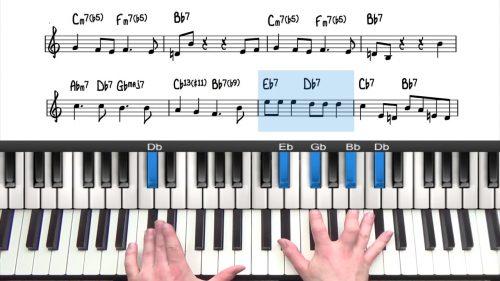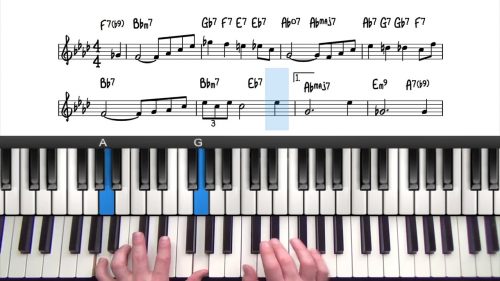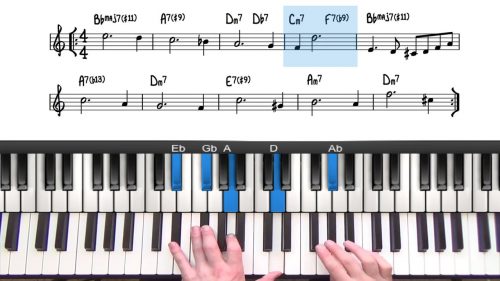Beautiful Love Tutorial Lesson
Victor Young’s Beautiful Love is one of the most popular standards amongst jazz musicians. Virtually all of the jazz piano greats have recorded a version – some of PianoGroove’s favourites can be found below in the recommended listening tab.
Beautiful Love is commonly played as both a ballad and as a medium to up-tempo tune. In this lesson we create an arrangement for both of these styles. The form of the tune repeats so we are going to play very freely and ballad-like on the first time through and then switch to more of an uptempo swing style for the repeat.
The lesson starts with the usual left hand voicings and melody and then we build bigger voicings throughout the lesson.
We’re going to look at some interesting chord substitutions and also some rhythmic devices you can use to create a syncopated swing feel.
It would be worth checking out the lesson on block chords as we use this style of voicing extensively in the swing arrangement of this tune.
Practice Tips
There's many great recordings of this tune... listening to the masters of jazz is an essential part of your journey so make sure you dedicate a good proportion of your piano time to listening! Here's a few of our favourite recordings of Beautiful Love:
- Kenny Barron - Beautiful Love - with George Mraz & Ben Riley
- Bill Evans - Beautiful Love
- Hank Jones - Beautiful Love - with Dave Holland on Bass
- Art Tatum - Beautiful Love





On Beautiful Love…..Any chance you can make us your usual nice clean lead sheet to work from? Yours are so much nicer than the others. Leaves me more room for my own notes.
awesome thanks for sharing these records Lori!
Hey Lori, sure thing… I’ll get this done today and send it you via email 🙂
Hi Hayden any idea when we can expect the transcription for this tune?
Hi Paul,
Yes leave this with me. This was one of my earlier tutorials when I didn’t record a midi of the performance.
Also, the lesson doesn’t include a full ‘once through’ either, as the lesson format has evolved along with the supplementary download materials..
I will record a full time through in midi and audio, and also in the process create the transcription. I’ve added it to my to-do-list and I’ll get to it asap Paul 🙂
Cheers,
Hayden
Hi Hayden
Not a problem really and wouldn’t prioritise this as I have many more tunes to learn (haha) and can pickup from the video OK
Cheers
Paul
Hayden, there seems to be a problem with loading videos this morning.
Hi Joel, thanks for letting me know. I have just pushed an update on the video player which should help fix the issue.
You can also try using a different browser (Chrome, Safari, FireFox etc..) and this will often fix the issue.
I am working on this now to get it resolved on all browsers.
Cheers,
Hayden
Hello Hayden.How much jazz standars should i learn to do a performance of some type?The Minum… thanks have a great day
Hi Ivan,
I think there is no set amount. I would recommend first play for your family, then your friends, then perhaps in public.
One thing you must understand Ivan…. much of the music i teach is ‘background music’. I talked about that here in this forum thread: https://www.pianogroove.com/community/t/mastering-perfect-background-piano/1004
The more jazz standards that you learn, the better your harmonic language will become, and the more confident you will feel.
Also check out the lesson on creating introductions here: https://www.pianogroove.com/jazz-piano-lessons/1625-436251-progressions/ – adding a nice introduction will make your arrangements sounds more professional – and it will also allow you to add your personal touch to the tunes you are playing.
Cheers!
Hayden
Hi Hayden!That is what i really want…i live near a touristic city in brazil..with lots of fancy restaurants and bars near the beach. .So i m looking for some oppotunity to get out and play my jazz repertorie ..i play for my Family and friends all day lol só i m ready for the next level
That’s exciting Ivan…and I’m excited for you 🙂
I’d recommend building a list of tunes that you are 100% comfortable with so that you do not need the lead sheets. Learn the chord changes by memory and have fun.
Understand that unless you are on a stage, ie. a concert hall kinda setting, then you are just playing background music, and 95%+ of people will not be listening to you. They are busy eating/drinking/having conversation. Don’t get me wrong, they are enjoying the ambiance you are creating, but they are not listening intently to what you are playing.
Furthermore, the vast majority of your audience will have no understanding of jazz harmony, and so they will not be able to tell the difference between a basic R-3-7 voicing, or something more harmonically complex.
The key Ivan… is to play the melody with conviction. ie. make sure the melody of the song is clear, stands out, and is instantly recognisable.
That is the one thing that your audience will notice, and that they will be able to connect to. A strong melody of a song that they know is something everyone can relate to. It takes someone with jazz knowledge/experience to appreciate and comprehend a chord voicing containing upper extensions/alterations etc…
Make your melodies sing, and your audience will love it.
Enjoy my friend 🙂
Hayden
Thanks for your support and tips.The things is ..all the standards( i know are arranged by you xD..só i have learned the standards by memory but without the chord progressions..they sound great and i play them very confidently..i think it is a problem i face…because if i play the lead sheet like it its written it sóunds dull and Boring..so i stick with what you teach us here…do you think i m doing it wrong?
Check out the 1625 Progression lesson mentioned above, and just try cycling around that progression with different chords. Perhaps introduce some right hand improvisation if you feel comfortable. That’s a nice way to add your personal touch. and then simply drop back into the tune when you are finished playing around with the 1625.
I will make a lesson on this, as it is something I have been playing around with myself and I have a few tips to share.
Cheers,
Hayden
Hello Hayden good night to you, hope you are doing great.Talking about personal touch..this couple days i have been organazing all the standard i have learned.. i play all of them using the irealpro app…só i set the song to repeat 3 times..the first one i play it normaly and with the third one i do the same thing..but on the second one i improvise all the song . i play it only with seventh chords or invertions of this seventh chords…and i use all the improvisation tools i learned from the 12 bar blues lessons.What do you think of my approach? I m organazing my songs to play them live só this approach makes a good portion of the songs last at least 6 minutes .(wich is good for covering time)Some song s like tune up or blue in green are very short só i adjust the repetitions from 3 to 5 or 7..following this pattern:first time i play it normally second time i improvise and this pattern repeats until the song ends.This week i got in touch with a lot of restaurants owners and for what i can tell they like a guy who can play a at leats 3 hours of piano playing…só for me to get closer to that goal i m forced to abuse the art of improvisation lol …at least for now .
Hi Ivan,
I would recommend that you set the repeat to 20+ times.
Cycle around and around.
Play an improvised idea, something very simple, then keep playing it, developing it, changing it slightly etc…. tell a musical story.
You must also listen and transcribe, check out this course: https://www.pianogroove.com/jazz-piano-lessons/how-to-transcribe-lines-solos/
This will give you the musical ideas, the phrasing, the articulation. This is the things that I cannot teach.
Most importantly:
1) set the iRealPro repeat to maximum and cycle around and around with your improvisation, some will sound good, some will sound bad, just keep cycling around and around the form.
2) Listen to as many version as possible of this song, and try to transcribe some material. Try to emulate the phrasing.
I hope this helps 🙂
Hayden
Thank you for your answer.So this approach can olso work for a background music cocktail night? I m really getting into discovering how things work..só your answers helps me greatly…I have 15 jazz standards ready to go ..só i m figuring out how to present them on a background music type of gig.You told me 95% of people are not listening só that helps haha..If i can do what you Just told me on a live gig i m set and ready to go.I know some of my questions are repetitive but if i m able to have a solid understanding of this things i Will be able to do a good job.I have 0 experience on jazz background music.But im slowly getting the pieces together.
It would be cool to have a course about playing on live gig or events..you could talk about all the things that your are telling me here and more…things like acoustics, volume or playing solo or with the ireal pro…sometimes it gets a little bit difficult to understand something you have never done(i have never played on restaurants).You could give tips about faking songs like i mentioned on my other comment…pherhaps giving tips on how to overcome some spontanious events that come from nowhere like a Singer wanting you to play for her…or a sax player who wants you to comp him…it could olso have info about how to negociate your work for an event and set a payment..or types of payments..how to present and prepare yourself for such events..how to give a good impresion that can get you more work offerts. how to network in an efective way in such enviroments .. etc
Hi Hayden,
Great tutorial as always 🙂
I do have some questions:
1. On 6:28 in the tutorial in the part when you reharmonize, I’m struggling to get to the E on the left hand. In your opinion what is the best way to get around this?
2. On 7:19 in the tutorial for the DM7 chord, do you simply voice the chord in the left hand with D,A Notes and on the right hand you simply play F, A,C,E and E in the note in the melody?
Also, it seems that after you play the chord with the melody note you hit the DM7 rootless chord.
Is there any specific reason to play the chord then play the same chord again rootless?
Thanks.
Ariel
Hi Ariel 👋
Apologies for the late reply!
For question 1, you could leave out the 3rd so that you are just playing the C7 shell in the left which is C and Bb. This will still give you the dominant sound. You could also play the 3rd an octave down, so your left hand plays C-E-Bb, instead of C-Bb-E. The texture will be slightly different, but the chord quality will be the same.
For question 2, yes you are absolutely right. I play D & A (the root and 5th) in the bass and then come up to play a rootless voicing with the added 9th for extra colour. The root and 5th is a unique interval because we can play it way down in the lower registers of the piano without it sounding ‘muddy’. This utilises the lower registers of the keyboard to create more depth and it also adds some rhythmic interest to our left hand instead of just playing 1 voicing.
Hope that helps and enjoy this tune!
Cheers,
Hayden
Wow. What a lovely tune. What planet have I been on?
Thanks Adam, glad you enjoyed the tutorial, and yes this is a fun little tune to play around with!
Cheers, Hayden
Hello,
For quartile voicings, I notice that most of the time the notes are seperated by 4th notes but there is often two notes seperated a 3rd apart (The bridge of Body & Soul Pt 2 tutorial has a better example of this) Is there a general rule as to which notes should be seperated by 3rd’s and which should be seperated by 4ths or does that depend on what is being played in the melody? Thanks in advance!
Hi Hayden! Many thanks for this great tutorial. I was curious about the Ab13 passing chord, about 11:58. Does this work because it’s a half-step above the target chord?
Thanks!
Hi Theo 👋🏻
Happy New Year.
Yes that is indeed the reason. We can approach any chord with a dominant chord a half step above. This works particularly well before the V7 chord and also before the I chord in a ii-V-I progression.
Check out this lesson for more information: https://www.pianogroove.com/jazz-piano-lessons/slick-dominant-passing-chords/
Let me know if you have any further questions on the topic.
Cheers, Hayden
ps. I received your emails and aplogies for the late reply… I will get around to them this week. I’ve been crazy busy with our new teacher joining us next month (a famous gospel specialist) and I have a huge backlog of emails to catch up on. Please bare with me. Cheers!
Thank you for the wonderful lesson and course, Hayden. As always – you mesmerize us with how detailed the explanation of the concepts are and your interpretation and rendition “WOWS” us all 🙂 So tastefully and beautifully played. – Kristeta
My question by the way 🙂 Please if you could also give us any tips regarding the pedal use when playing this song. Thank you so much!
Thanks Tina – and a very happy and musical new year to you! :–)
Cheers, Hayden